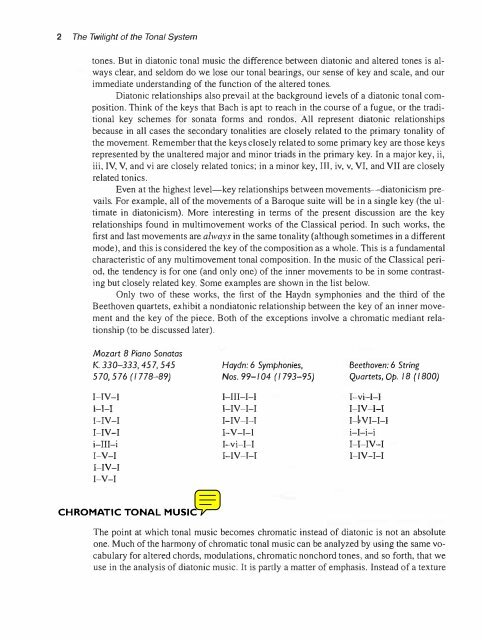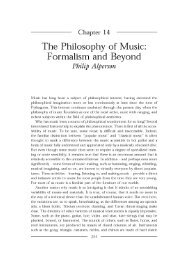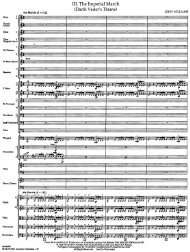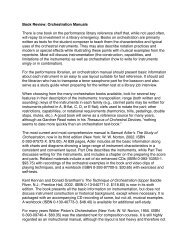TWENTIETH- - Synapse Music
TWENTIETH- - Synapse Music
TWENTIETH- - Synapse Music
You also want an ePaper? Increase the reach of your titles
YUMPU automatically turns print PDFs into web optimized ePapers that Google loves.
2 The Twilight of the Tonal System<br />
tones. But in diatonic tonal music the difference between diatonic and altered tones is al<br />
ways clear, and seldom do we lose our tonal bearings, our sense of key and scale, and our<br />
immediate understanding of the function of the altered tones.<br />
Diatonic relationships also prevail at the background levels of a diatonic tonal com<br />
position. Think of the keys that Bach is apt to reach in the course of a fugue, or the tradi<br />
tional key schemes for sonata forms and rondos. All represent diatonic relationships<br />
because in all cases the secondary tonalities are closely related to the primary tonality of<br />
the movement. Remember that the keys closely related to some primary key are those keys<br />
represented by the unaltered major and minor triads in the primary key. In a major key, ii,<br />
iii , IV, V, and vi are closely related tonics; in a minor key, 1IJ, iv, v, VI, and VII are closely<br />
related tonics.<br />
Even at the highest level-key relationships between movements--diatonicism pre<br />
vails. For example , all of the movements of a Baroque suite will be in a single key (the ul<br />
timate in diatonicism). More interesting in terms of the present discussion are the key<br />
relationships found in multimovement works of the Classical period. In such works, the<br />
first and last movements are always in the same tonality (although sometimes in a different<br />
mode), and this is considered the key of the composition as a whole. This is a fundamental<br />
characteristic of any multimovement tonal composition. In the music of the Classical peri<br />
od. the tendency is for one (and only one) of the inner movements to be in some contrast<br />
ing but closely related key. Some examples are shown in the list below.<br />
Only two of these works, the first of the Haydn symphonies and the third of the<br />
Beethoven quartets, exhibit a nondiatonic relationship between the key of an inner move<br />
ment and the key of the piece. Both of the exceptions involve a chromatic mediant rela<br />
tionship (to be discussed later).<br />
Mozart 8 Piano Sonatas<br />
K. 330-333, 457, 545<br />
570,576 (1778-89)<br />
I-TV-I<br />
1-1-1<br />
I-IV-I<br />
I-IV-I<br />
i-III-i<br />
I-V-I<br />
I-IV-I<br />
I-V-I<br />
CHROMATIC TONAL MUSIC<br />
Haydn: 6 Symphonies,<br />
Nos. 99-104 (1793-95)<br />
I-III-I-I<br />
T-IV-I-I<br />
I-IV-I-I<br />
I-V-I-l<br />
I-v i-I-I<br />
I-IV-T-T<br />
Beethoven: 6 String<br />
Quartets, Op. 18 (1800)<br />
l-vi-l-I<br />
I-IV-I-I<br />
I-VI-I-I<br />
i-I-i-i<br />
I-I-IV-I<br />
\-IV-I-I<br />
The point at which tonal music becomes chromatic instead of diatonic is not an absolute<br />
one. Much of the harmony of chromatic tonal music can be analyzed by using the same vo<br />
cabulary for altered chords, modulations, chromatic nonchord tones, and so forth, that we<br />
use in the analysis of diatonic music. It is partly a matter of emphasis. Instead of a texture









